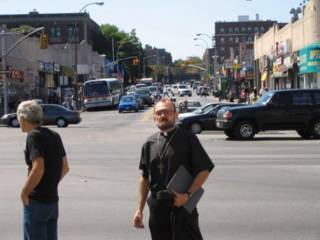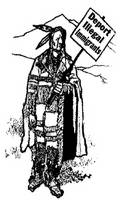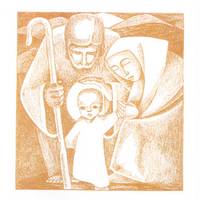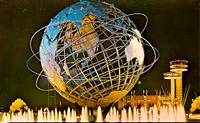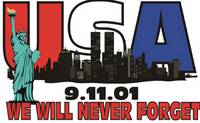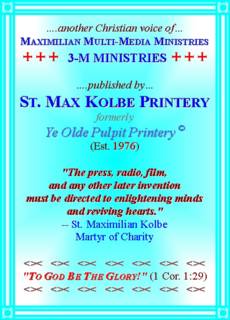LIGHT THE WAY! Blessing Candles & blazing bonfires -- in Thanksgiving for Motherhood
On this 40th day after The Nativity of Our Lord (a.k.a. "Christmas"), the Theotokas (Birth Giver of Our Lord) -- in humble obedience to that Jewish Old Law (Leviticus 12:2-8) which requires a woman to be ritually purified forty days after bearing a son (and 60 days after the birth of a daughter) -- presented Jesus to the priests in the Temple. Afterwards she could attend religious services again, and generally go out in public. So, rather than a lamb, Mary offered the gift of a pair of turtle doves, like the poor, because she was poor, and was not ashamed to acknowledge it before the world. Also -- inwardly she already knew that she was offering up the Most Supreme Lamb, our Pasch.* Dom Prosper Gueranger, O.S.B., wrote in 1871 that, "We apply the name of Christmas to the forty days which begin with the Nativity of our Lord, December 25, and end with the Purification of the Blessed Virgin Mary, February 2. It is a period which forms a distinct portion of the Liturgical Year..."
When New Year's Day is past and gone;Christmas is with some people done;But further some will it extend,And at Twelfth Day their Christmas end.Some people stretch it further yet,At Candlemas they finish it.
Modernist New Riters and feminists have a problem with this politically incorrect Jewish tradition that women were considered unclean after the birth of a child and were not permitted to enter the Temple to worship. A Jewish woman was considered ritually unclean until her purification in the mikvah, the ritual bath which is also used for the purification of menstruating women as well as in the case of proselytes and those who had been in contact with the dead. So hence the recent new name and focus of this day, "The Presentation of Our Lord in the Temple".
Mary was not subject to the Law of Purification for she had not, like other mothers, conceived in sin. Therefore, she did not need purification. Yet she humbly placed herself with her divine Child among sinners and fulfilled the law by which these were bound. She also wanted to thank God for the favors He has shown to their ancestors because that law of the Jews was given to encourage them to thank God for the preservation of the first-born of their ancestors from the hands of the destroying angel; (Exodus XII. 12.) Just as important, she did not want to scandalize those who did not know that she was not required to observe it. "Nothing was impure in her conception, nothing impure in her birth; there was nothing to be cleansed, for the Child itself was the origin of all purity, and came into the world to purify it from sin. Truly, O happy Virgin, thou wast not in need of purification, but thou wouldst pass as a woman among women, as thy Son also passed for a child among children." (-- St.Bernard)Jesus was brought to the Temple so that He might be offered to God. Almighty God had commanded the Jews to offer their first-born sons to Him in grateful commemoration of the destroying angel having spared their first-born at the departure from Egypt, when all the firstborn of the Egyptians were slain. (Exodus XII. 12.) These children had to be redeemed afterwards by certain gifts. (Exodus XIII. 13.)
Although the OT Jewish law of purification no longer applies to Christian women, the Orthodox and Traditional Catholic churchs complies with the spirit and true intention of that honorable law -- giving new mothers the protection, quiet, rest and attention which their maternal nature requires. Therefore, The Church permits women, to remain at home with their newborn for six weeks after childbirth, or as long as circumstances may require, without attending Holy Mass, in order to care for their child and their health. ....Afterwards, they go to the Church for their "Churching of Women" (bestowed at the Altar before Mass since the eleventh century) to procure the blessing of the priest, to give thanks to God for their safe delivery, to dedicate their children to Him, and to implore of Him, with the priest, grace to bring up their offspring in piety and holiness. This "Churching" implies NOTHING to be ashamed of and shouldn't be omitted by families who desire God's blessing and want to give Him thanksgiving. (There is also a special church blessing for pregnant families.)
Upon doing so, Simeon the aged and nearly blind prophet, saw the infant Jesus and proclaimed Him to be "a Light to lighten the Gentiles, and the Glory of Thy people Israel." (Luke 2.22-32). Ever since, this day (a.k.a. "Candlemas Day") has always involved a celebration of light. The most famous of these customs -- and the one from which the feast takes its common name -- is the blessing of, and procession with, candles. A solemn and penitential procession in which the celebrant wears purple; exits and then re-enters the church, at which point the purple is cast aside for the jubilance of white and a joyful Mass is offered. One of the more distinctive features of this Mass is that the candles are held lighted in the hand during the Gospel and from the Sanctus to the Communion. Other candles used in the procession are also blessed on this day. Families traditionally had most or all of their special candles -- for Advent, St. Lucy's Day, Christmas, or the family shrine -- blessed on this same day.
The day begins with five beautiful blessings of candles that invoke God's aid in living out allegorically what the light and fire of a candle symbolize: wisdom and illumination, purification and charity, etc. They symbolize that Jesus Christ is the light, the truth and the way. They also remind us that, like the five wise virgins, we should go to meet Christ with the light of faith and good works. They are blessed that by their pious use and the prayers of those who devoutly carry them, we may obtain from God health of body and soul; that our hearts, through the doctrine of Jesus and the grace of the Holy Ghost, may be interiorly enlightened; and that the fire of the love of God may be kindled in our hearts, purify them from all remains of sin, and make us partakers in the joyous light of heaven, which will never be extinguished.
It's a pivotal feast since it's 40 days since Christmas and the 40 days of Lent will begin next Wednesday. And since it falls halfway between the winter solstice and the spring equinox, Candlemas Day's association with light also made it the appropriate day for "predicting" the weather. According to an old legend, if the sun shines bright for the better part of the day, it means forty more days of winter. From this quaint superstition came today's "Groundhog Day." This custom was brought to America by the Pennsylvania Dutch (German settlers) who believed that all hibernating animals come out to check on the weather. If the animal saw its shadow, then six weeks of bad weather would follow and the animal could go back to sleep. However, a cloudy day meant that spring was coming soon and the weather until then would be moderate. In Western Europe, this was also the time for preparing the fields for the first planting. An Olde English rhyme went: "If Candlemas Day be fair and bright, Winter will have another flight; But if it be dark with clouds and rain, Winter is gone, and will not come again."
Tomorrow is the Feast of St. Blase which is also called "Little Candlemas Day". It commemorates the Armenian Bishop of Sebaste, in Cappadocia, + Blaise (martyred in the 4th century.) who miraculously cured a little boy choking on a fishbone lodged in his throat. He spent most of his time praying on a hill outside the city, where wild beasts used to come for his blessing. During the persecution of the Christians under Licinius he was seized and taken before the governor. On the way a woman besought the saint to relieve her child, who was choking from a bone in its throat. He laid his hand on the child's throat and prayed, and it was healed. After being tortured by having his flesh torn with wool-combers' irons, St. Blaise was beheaded (A.D. 316).
Ever since then, St. Blaise has been the patron saint of throats and wool-combers. Within this sacramental, a priest takes two crossed candles, puts them up to the recipient's throat, and prays: "Through the intercession of Saint Blaise, Bishop and Martyr, may the Lord free you from the evils of the throat and all other evils." "Saint Blaise Sticks" (pan bendito -- blessed breads which are especially popular in the Latin countries and central Europe) are distributed on his feast and kept in the home to be eaten for a sore throat.
In Mexico on this Feast of The Purification of the BVM, a sweet circular cake called "la Rosca de Reyes" is served with a doll baked inside representing the baby Jesus. The person who finds the baby in their slice is to host the forthcoming celebration Candelaria or Candlemas on February 2nd. When 20 or thirty guests are partying, often several babies are baked into the cake to spread out the cost of the next party among friends. The Rosca de Reyes was first used by the friars to evangelize. A small doll, representing the Christ child, is baked right in the bread - "hidden", to symbolize the hiding of the infant from King Herod's troops on the day of Los Santos Inocentes, the Holy Innocents.
In Europe on St. Blaise's Night, the peasants used to commemorate this Feast by lighting big bon fires on the hills and would use a blessed church taper to torch them. Why? I don't know; doubt if they did either, but BIaise = blaze. However, it seems appropriate to me that this is the day that I also burn all my old blessed palms, scriptures, retired American flags, worn out icons, reserved cotton from my sacarium saturated with OI Holy Oil, etc. OUTDOORS to make ashes for next week's Ash Wednesday. (So if any of you padres need extra ashes for next week then let me know.)
Prayer for Women after Childbirth: "Almighty and merciful God, Who didst lay upon our mother Eve the fit punishment for her disobedience that she should bear children in sorrow, I offer to Thee all the pains of my child-bearing in propitiation for my sins; and I thank Thee that, through Thy help, the fruit of my womb has been safely brought forth into the world, and new-born in Baptism. According to the example of the Mother of Thy only-begotten Son, I also offer to Thee my child for Thy holy service, and will earnestly strive to bring it up to Thy honor. To this end give me, through the intercession of the most blessed Virgin, Thy grace; bless me and my child, and grant that we may live according to Thy will here, and hereafter may obtain everlasting happiness. Through Jesus Christ, Thy Son, our Lord, etc. Amen."
PRAYER Heavenly Father! look down from Thy throne of mercy upon the face of Thy Anointed in whom Thou art well pleased. Behold, He is this day offered to Thee in the temple for the sins of His brethren. Let this offering please Thee, and move Thee to have compassion on us sinners. In consideration of His humility and obedience, forgive us our pride and disobedience, and grant us, that purified by His blood, we may one day, having like Simeon departed this life in peace, behold Thee as the eternal Light which shall never be extinguished in the temple of Thy glory, be presented to Thee by Mary, our beloved Mother, and love and praise Thee forever. Amen.
LET US PRAY for the Holy Father who was hospitalized at Gemelli Polyclinic Hospital in Rome at 10:50 p.m. last night after suffering a "crisis of larynx spasms and breathing complications" as a result of the flu. His condition is serious and made worse by his Parkinson's disease.









